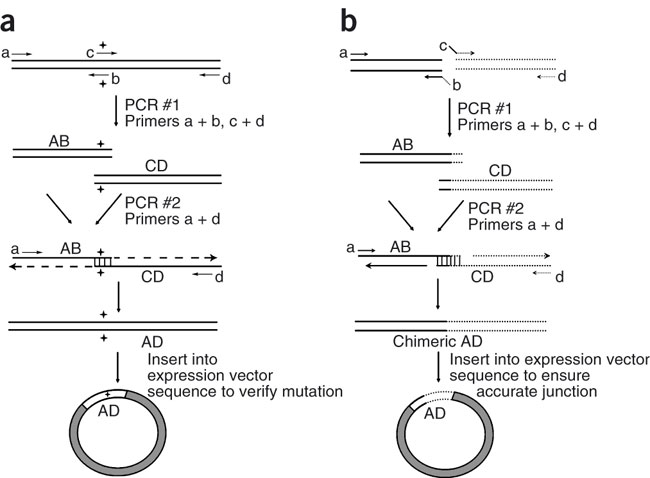overlap extention
Table of contents
1.  don't feel shy, cick on "Edit" and add your information on this page [edit]
don't feel shy, cick on "Edit" and add your information on this page [edit]
|
|
|
PCR-mediated overlap extension can create specific nucleotide mutations or generate chimeric gene products. 2. si conducono 2 reazioni di PCR in parallelo: una con i primers a e b e una con i primers c e d 3. mescolando i prodotti di reazione, tra i prodotti del reannealig, ci sarà il segmento AB che si appaia con CD nella zona mutata. 4. Allungamento da parte della DNA Polimerasi che sintetizza in direzione 5'>3' 5.Amplificazione mediante PCR con i primers a e d. 6.Inserimento in un vettore di espressione per verificare e studiare l'effetto della mutazione
|
 From the following article: Gene splicing and mutagenesis by PCR-driven overlap extension Karin L Heckman & Larry R Pease Nature Protocols 2, 924 - 932 (2007) |
Figura b 1- Conduciamo in parallelo due reazioni di PCR su due sequenze di DNA non fisicamente unite tra loro: una con i primers a e b, l'altra con i primers c e d. I primes b e c sono solo parzialmente complementari al 5' al filamento di DNA stampo per cui la reazione di PCR produce segmenti di DNA con estremità adesive. 2- Fusione delle sequenze di DNA generate nella prima tappa mediante le estremità complementari dei primers c e d. 3- Allungamento da parte della DNA Polimerasi. 4.Reazione di PCR per amplificare i prodotti di fusione utilizzando i primers a e d. 4- Inserimento del gene chimera in un vettore di espressione per assicurarci di aver ottenuto il risultato voluto. |
|
The Overlap extension polymerase chain reaction (or OE-PCR) is a variant of PCR which can:
a) insert mutations at specific points in a sequence, further than ~55 nucleotides from either end and/or
b) produce polynucleotides from smaller fragments.
To insert a mutation into a sequence, a primer is generated depending on requirements. A single substitution may be included or a totally new sequence added at the 5' end. If a deletion is required, then the continuation of the sequence 5' of the deletion effectively becomes an addition. The 3' end must be complementary to the template strand so that DNA polymerase can copy the template from the primer (DNA polymerase can only copy DNA in one direction; 5' to 3').
Once the primer has annealed to the template, the DNA polymerase proceeds to the end of the template. The duplex is denatured and the second primer anneals to the newly formed DNA strand, containing the first primer. Replication proceeds to produce a strand of the required sequence, containing the mutation.
The duplex is denatured again and the first primer can now bind to the latest DNA strand. The replication reaction continues to produce a fully dimerised DNA fragment. After further PCR cycles, to amplify the DNA, the sample can be separated by agarose gel electrophoresis, followed by electroelution for collection.
Efficiently generating oligonucleotides beyond ~110 nucleotides in length is very difficult, so to insert a mutation further into a sequence than a 110 nt primer will allow, it is necessary to employ overlap extension PCR. In OE-PCR the sequence being modified is used to make two modified strands with the mutation at opposite ends, using the technique described above. After mixing and denaturation, the strands are allowed to anneal to produce three different combinations as detailed in the diagram. Only the duplex without overlap at the 5' end will allow extension by DNA polymerase in 3' to 5' direction.
Following separation, the eluted fragments of appropriate size are subject to normal PCR, using the outermost primers used in the initial, mutagenic PCR reactions.
